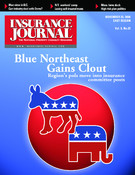Revenue growth, the quality of a book of business, the caliber of producers, strategic drivers and the overall level of client service — these are the typical considerations that affect an agency’s profitability and valuation. But one of the most important and under-addressed factors affecting an agency’s valuation is expense management. Principals not paying enough attention to overheads and profit margins are not maximizing the value of their businesses.
Agencies have historically been valued using a variety of standard valuation methodologies, including comparable transactions, discounted cash flow analyses and the use of market multiples applied to an agency’s net revenue and EBITDA (earnings before interest, taxes, depreciation and amortization). Although market observers tend to quote price-to-revenue multiples as the “rule of thumb” for valuations, the more pertinent and accepted measurement is based on price-to-EBITDA multiples.
“The higher an agency’s profitability — measured by its EBITDA margin — the higher the correlated EBITDA multiple that would likely be achieved in a third-party sale,” said Lou Caltavuturo, vice president of Hales & Company, a firm specializing in mergers and acquisitions and valuation services to insurance brokers globally. “This means agency principals need to exercise a disciplined expense management philosophy both to maximize the firm’s valuation and also to motivate them to explore and adopt new technologies and services to improve profit margins for the long-term.”
“Agencies, in general, have not done a good job of managing expenses and seeking out efficiencies in their operations,” reinforces Greg Thompson, president of Thomco Insurance. “We need a better model. Most buyers will not come in and make an agency more efficient. They’ll be looking to improve cash flow through higher revenues.”
That better model is built on driving productivity by better deploying and utilizing people, processes and technology infrastructure, and calibrating this powerful combination to more sophisticated market segmentation. The ability to underwrite and find markets is important. But an agency’s total productivity as defined above is key to its viability and future success.
Infrastructure and automation
Many agencies today remain heavily reliant on paper, but there is a definite and on-going trend towards moving to a paperless environment and automating processes that previously were extremely time-consuming and challenging to audit.
IT infrastructure determines how information is input into the agency system, how it is analyzed and utilized, and how it is transferred between customers and markets. Due diligence is necessary to find systems that don’t get in the way, but rather facilitate speedy communications and allow data manipulation to provide a deeper understanding of the agency’s client risk profile.
Optimizing technology use, though, depends not only on the system, but also on how the system is used. Developing a culture focused on continuous process improvement and training staff to fully utilize system features allows productivity enhancements to flow through both to the top and bottom lines, thus enhancing the agency’s profitability and valuation.
Market segmentation
A second way to improve agency productivity is to improve the agency’s bind-to-quote ratio by ensuring that marketing and sales efforts focus on prospects most likely to purchase the agency’s offering at a profitable margin. This “market segmentation” helps ensure the highest return on marketing and sales expenditures. Done well, it requires ever-deeper understanding of the needs, risk profiles and demands of the agency’s target clients to better frame the service offering, positioning and messaging that resonate for them.
But for an insurance agency market segmentation is about more than getting the most out of marketing and sales dollars. It’s also about accurately assessing risks. The most forward-looking agencies — particularly managing general agencies — are developing predictive models and risk-scoring templates to achieve industry-leading underwriting results. Predictive models crunch huge volumes of historical data to identify possible indicators of loss. And scoring templates create a more rigorous and analytical approach to individual risk selection and pricing.
Jeremy Hitzig, CEO of The Distinguished Programs Group, a New York-based program manager specializing in real estate, commented, “We’ve spent more than a year developing proprietary scoring and predictive models. We believe that these efforts will ultimately yield superior risk selection, improve loss ratios and allow more accurate and competitive pricing on our portfolio of risks.”
Getting more out of people
The greatest potential impact for improving margins and productivity concerns the agency’s most critical resource: its people. Most agencies’ biggest expense is people and it is not uncommon for 65 to 80 percent of an agency’s operating expenses to be payroll and benefits related. Exploring ways of doing more business with the same people is, therefore, a preoccupation for many agency principals.
For instance, the average CSR spends more than 50 percent of the time processing documents and less than half of that time communicating with, or visiting, clients. Freeing staff from processing work translates into their spending more time potentially writing new business, improving overall customer service and completing renewals on a timely basis.
For this reason, many agencies are looking for creative ways of growing their platforms. One approach is remote staffing. There are two basic models. In the first, the agency directly employs U.S. staff members who work from home. A second approach is to engage a company that specializes in remote staffing.
Offshore remote staffing
In the remote staffing model, the agency is able to leverage educated professionals from emerging countries like China or India, who are trained on the agency’s system. The advantages to this approach includes: time difference, scalability, and cost savings. Employees working in China or India function like a night-shift and thus enable agencies to function virtually around the clock. There is a ready supply of university-trained employees motivated by the opportunity to work in an international environment as part of the U.S. insurance industry. Plus, there is significant cost savings to employing staff in China or India versus their domestic counterparts.
Typically, agencies are able to save 40 to 60 percent on payroll costs and start to see significant returns on two common measures of agency productivity and profitability: revenues per dollar of payroll and earnings per employee.
Agencies with high processing loads that follow consistent rules and can be captured in a set of workflow procedures are good candidates for the remote staffing option. The types of tasks that agencies typically outsource to remote staffing specialists include application entry, policy checking, loss summaries, proposal generation, endorsements, MVRs, inspection reviews, certificate and policy issuance, rating, invoicing and claims reporting.
By combining new staffing strategies with the right IT infrastructure and market segmentation, agencies are able to dramatically improve not only their competitive advantages but also their long-term agency prospects and valuation.
Dan Epstein is chief executive officer of ReSource Pro LLC (www.resourcepro.com), which provides remote staffing for insurance managing general agencies and retail agencies.
Topics InsurTech Agencies Profit Loss China India
Was this article valuable?
Here are more articles you may enjoy.


 Experian: AI Agents Could Overtake Human Error as Major Cause of Data Breaches
Experian: AI Agents Could Overtake Human Error as Major Cause of Data Breaches  Door of Swiss Bar Where 40 Died in Fire Was Locked, Says RTS
Door of Swiss Bar Where 40 Died in Fire Was Locked, Says RTS  10 Highest Class-Action Settlements in 2025 Eclipsed $70B Total: Duane Morris
10 Highest Class-Action Settlements in 2025 Eclipsed $70B Total: Duane Morris  Adjusters Launch ‘CarFax for Insurance Claims’ to Vet Carriers’ Damage Estimates
Adjusters Launch ‘CarFax for Insurance Claims’ to Vet Carriers’ Damage Estimates 



